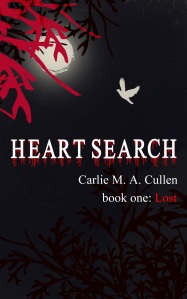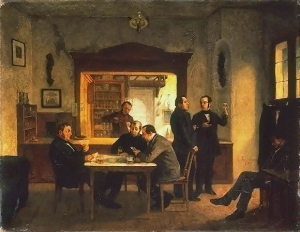 I love writing and I love my characters, but they are so stubborn about some things. Of course, many of them have ‘Y’ chromosomes, but still…. It’s frustrating because they don’t want to to talk about how they’re feeling.
I love writing and I love my characters, but they are so stubborn about some things. Of course, many of them have ‘Y’ chromosomes, but still…. It’s frustrating because they don’t want to to talk about how they’re feeling.
Oh, for the love of Tolstoy–don’t they get it? I’m a woman. I need you people to talk to me. Tell me what’s going on in your imaginary head.
It’s difficult to show the characters’ emotions and thought processes when it’s so much easier to just say he felt, or she was some emotion. These thoughts and feelings are central to making our characters feel real. But describing them from a distance, as an author must do, may disconnect the reader from that character.
Sometimes, descriptions don’t allow the reader to experience the moment with the character. Instead, the author is telling them how the character feels.What we must ensure is that our readers remain immersed in the narrative, that no ‘speed-bumps’ come along to knock them out of it. 
One of the best at this is Carlie M.A. Cullen, whose urban fantasy series Heart Search featuring a coven of vampires is gaining in popularity. I think her books are so compelling because of her ability to draw a reader into the character without going over the top. So, how does she do it?
The opening line of chapter one of Heart Search Book 1, Lost reads like this: The sun, a ferocious golden orb, burnt into his skin as Joshua wandered aimlessly through the country park.
She could have just written The sun was hot and Joshua was killing time in a park.
But she didn’t, and the story is better for it–AND she showed you both the scene and Joshua’s mood in that one sentence.
So what can we learn from reading our favorite authors? We can see how they craft their tales, and we can learn those skills. Painters do this all the time, and we paint with words. 
Let’s pretend we’re writing a fantasy novel. We can go over the top, like a painting by Herbert Gustave Schmalz, or we can find a happy medium between too much and too little. There is no need to sink into overly sentimental and exaggerated pathos in order to inject feeling into our work.
Here we have a character who is on the run from a creature of some sort. 1. He was afraid. He was terrified to look back.
Example one tells the reader how the character feels. We might write this in our first draft when we are just trying to get the story out of our heads. An unskilled writer would consider it just fine the way it is, as it expresses his thoughts perfectly.
However, it tells the reader how to feel, and readers really don’t like being told what to do.
2. He wiped the sweat from his brow with a trembling hand, fear from his narrow escape coursing through his veins. Heart pounding, he leaned against the wall, listening for any sounds that shouldn’t be there before chancing a glance around the corner.
Personally, I would read book number two over book number one, because it’s more interesting and makes me want to know more about this character and his problems. We need to use physical symptoms a character might experience combined with their actions, but we need to describe them in such a way that it is a natural part of the scene.
John slid down the wall, sitting in the mud, his breaths coming in hard, ragged gasps. Something trickled down his cheek, and wiping it, his hand came away with blood.
Lord Deccan’s fist hit the table. “Wine now, you miserable worm–or I’ll cut off your other ear!”
The one-eared innkeeper scuttled to the cellar. He quickly searched the shelves filled with dusty jars of cheap wine, settling at last on a vintage he thought might suffice.
Baldric’s guests normally drank from wooden tankards, but he knew that wouldn’t suit. There was a goblet, one he’d come by in a peculiar way, but it was a fine cup and would do well enough to stave off a tantrum of the lordly variety.
His shoulders hunched in anticipation of trouble, he approached the angry lord’s table. Setting the only goblet before the nobleman, he left the bottle and stepped away, bowing with feigned obeisance. Baldric had survived the war with all but his left ear intact, and intended to remain that way.
 What we are doing here is exactly like interpreting what our loved one is telling us, when he/she refuses to use their words. Seeing them sitting slouched in the chair, clicker in hand and numbly flipping through channels is a good indication of their mood. So we must picture the scene and describe it .
What we are doing here is exactly like interpreting what our loved one is telling us, when he/she refuses to use their words. Seeing them sitting slouched in the chair, clicker in hand and numbly flipping through channels is a good indication of their mood. So we must picture the scene and describe it .
We must show the emotions as they are reflected by the physical cues our characters give us, but don’t tell them–a difficult trick to master but one we must all do if we want our work to engage the reader.









A great entry, Connie. Thanks for sharing. Carlie is fantastic!
LikeLike
-So glad you agree, Dean! Your own work is pretty awesome, if you want to know the truth!
LikeLike
Reblogged this on Carlie M A Cullen and commented:
This is a lady after my own heart. She believes, as I do, that showing emotion in writing engages the readers much more than just telling what the characters see and feel.
This is something I’m passionate about in my writing and have written articles on this very subject, but don’t just take my word for it, see what Connie J Jasperson has to say (oh, and by the way, I happen to get an honourable mention too!):
LikeLike
Thank you for the kind words Carlie ♥
LikeLike
Excellent post. Thanks for sharing, Connie. This will go in my writing tips file.
sherry @ fundinmental
LikeLike
@Sherry – I’m glad you enjoyed it–and I’m pleased to meet you!
LikeLike
Great to meet you too. I saw your post on Carlie’s blog and had to come by. Have a great day!
sherry @ fundinmental
LikeLike